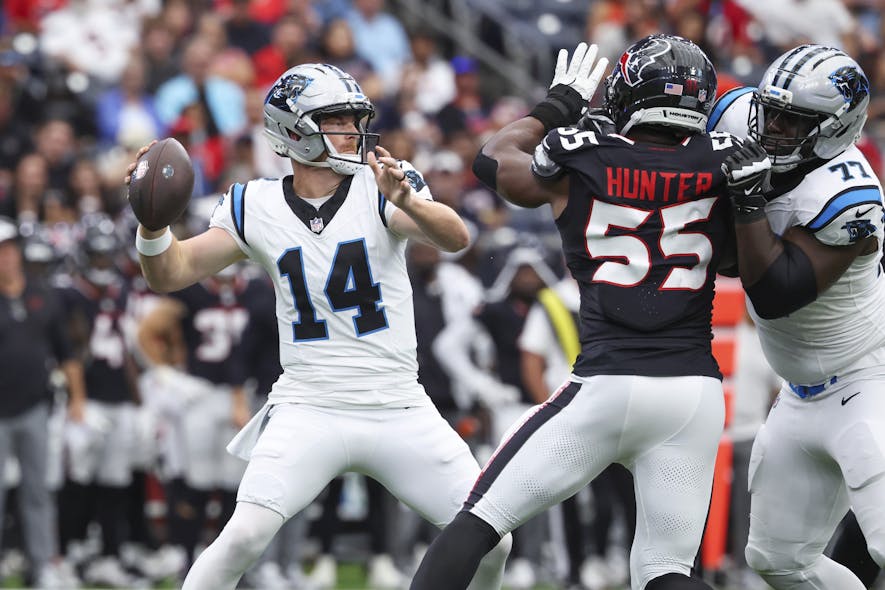With the season finally here, a final strategy session on the overall roster strategy for title-seeking dynasty GMs includes discussing high-variance outcomes.
Consistency is a Myth
One myth running rampant in fantasy circles is seeking "safety" or "consistent" fantasy players. Mathematically, 99% of the consistent fantasy players are those without an elite ceiling. For the range of results for a player to be consistent, they must be a tighter cluster of points than their peers. Once a player hits 20, 25, or 30 points in a game, they will be high variance with any five or 10-point outings. Also, fantasy is built upon a small string of chaos-filled plays by 22 players over 17 weeks with a variety of weather, matchups, injuries, and close calls for touchdowns, penalties, etc. Being consistent through all those factors is a fruitless goal and one that will not help your end result. The big pop games from players on your roster help far more than a poor game hurts your game outcome. That leads to the second point...
Few Players Matter...Much
While we all have the nail-biting results down to the wire on Monday Night Football, those are generally a rarity. There are numerous studies on the margin of victory, most of which point to a gap of 20-25 points on average between fantasy teams. This is larger than all players in a lineup except for maybe the quarterback position, based on their points-per-game. This also means that having one more elite player in a lineup (say, upticking from 10-12 points-per-game to 20 points-per-game) does not change as many game results as one would assume. Like football, fantasy is a team game and a cluster of chaotic events adding up to a singular weekly number.
Based on the historical data, increasing a player in your lineup by 10 PPG would shift a loss to a win 27% of the time. A five PPG bump shifts the result 15% of the time. So the first lesson is that a few players impact your aggregate season result by more than potentially one game. This also applies to the reverse, where too much blame is applied to a single player. Think Mark Andrews last September was viewed as the reason a team starts out 1-3. Even if Andrews had averaged 10 PPG more during the month, it likely would have shifted one result on average, turning an 0-4 team into a 1-3 and a 1-3 into a 2-2 early record.
The second lesson is acquiring these impact players earlier in the season. As a team, getting off to a good start and pushing for a coveted bye in leagues where six teams make the postseason is the most optimal. As a slow-starting team, acquiring a player who will make a difference is more about making the playoffs rather than securing a bye week later in the season, a sub-optimal outcome on its face value.
Maximize Your Bench
With the season here, every roster spot is a finite and valuable resource. The obvious approach is to check every week for any player designation (IR, PUP, etc.) that is eligible for an IR demotion to create a free roster spot.
An advanced strategy in-season is to float roster spots. Defenses and kickers (in applicable leagues) are the easiest to exploit. Dropping a kicker or defense for waiver (or hold) options mid-week allows for speculation plays into the weekend. Typically, this surrounds an ambiguous injury situation that will be resolved by the end of the week's practice reports or by kickoff. This also allows for a few days to explore trade avenues to clear a roster spot if needed. In rare leagues where all kickers and defenses are generally rostered, this is the setting where floating roster spots in this manner will not work.
A secondary method of floating roster spots surrounds injured or bye-week players. A league with enough depth to roster backup quarterbacks (Superflex) or shallow enough to not roster all of the primary backup running backs is an ideal setting to float these positions. When a backup quarterback or running back is entering a bye week, dropping them once the player will lock (might be any time post-waivers or close to kickoff in a worst case), a team can protect them from being acquired that week. The idea is that the player's starter cannot get injured during a bye week, and the backup will likely be more accessible (or not overly costly) to re-acquire the following week. Rather, take a roster spot for a backup whose starter is playing that week. While only a few percentage points within a singular week, stacking this strategy over many weeks of the season yields much higher odds of already rostering a primary backup when the starter does get injured in the week, saving valuable waiver resources the following week.
Continue reading this content with a ELITE subscription.
An ELITE subscription is required to access content for Dynasty leagues. If this league is not a Dynasty league, you can edit your leagues here.

